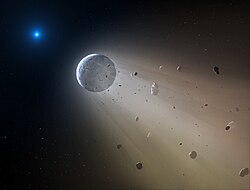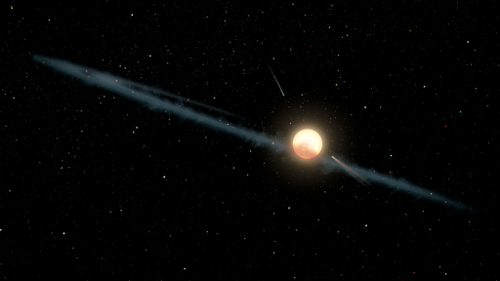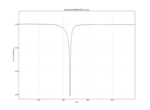붕괴된 행성
Disrupted planet천문학에서, 붕괴된[1][2] 행성은 행성이나 외부 행성, 또는 다소 작은 규모의 행성, 미행성, 달, 엑소문 또는 소행성으로 근처에서 또는 지나가는 [1][2]천체나 별과 같은 물체에 의해 붕괴되거나 파괴된다.괴사행성학은 그러한 [3][4]과정의 관련 연구이다.그럼에도 불구하고, 이러한 붕괴의 결과로 과도한 양의 관련 가스, 먼지 및 [5]파편이 생성될 수 있으며, 이는 결국 항성 주변 원반 또는 파편 원반의 형태로 모항성을 둘러싸고 있을 수 있다.따라서 궤도를 도는 파편 영역은 "먼지 고리"로, 모항성의 겉보기 밝기에 불규칙한 빛의 변동을 일으킬 수 있습니다. 이는 Tabby's Star(KIC 8462852) RZ Pisci와 같은 특정 변광성에서 관측된 별빛과 관련된 희한 깜박임 광도 곡선의 원인이 될 수 있습니다.um 및 WD 1145+017.[3][4]이러한 [6]별에서 과도한 양의 적외선이 검출될 수 있으며, 이는 먼지와 파편이 [5][7][8][9]별 주위를 돌고 있을 수 있음을 암시하는 증거이다.
예
행성
붕괴된 행성 또는 그와 관련된 행성의 일부로 여겨지는 행성들의 예로는 다음과 같은 것들이 있다: 'Oumuamua와[10] WD 1145+017 b, 소행성,[11] 뜨거운[12] 목성 그리고 다섯 번째 행성, 파에톤, 행성 V, 그리고 티아와 같은 가상의 행성들이다.
별들
행성을 붕괴시킨 것으로 여겨지는 모항성의 예로는 EPIC 204278916, 태비별(KIC 8462852), PDS 110, 물고기자리 RZ, WD 1145+017, 큰곰자리 47 등이 있다.
태비별 광도 곡선
태비별(KIC 8462852)은 F형 주계열성으로 [13]밝기가 최대 22%까지 어두워지는 등 특이한 빛의 변동을 보인다.이러한 불규칙한 변화를 설명하기 위해 몇 가지 가설이 제안되었지만, 현재까지 곡선의 모든 측면을 완전히 설명하는 가설은 없다.한 가지 설명은 "먼지 고리"가 태비별 [14][15]주위를 돌고 있다는 것이다.그러나 2019년 9월, 천문학자들은 태비별의 조광이 고립된 외계의 [16][17]교란으로 인한 파편들에 의해 생성되었다고 보고했다.
2019년 10월 10일부터 2020년 1월 11일까지의 광도 곡선(HAO)[22]
「 」를 참조해 주세요.
레퍼런스
- ^ a b Staff (22 December 2017). "Young Star RZ Piscium is 'Eating' Its Own Planets, Astronomers Say". Sci-News.com. Retrieved 23 December 2017.
- ^ a b Fryling, Kevin (21 December 2017). "IU astronomer's analysis helps discover that a star in the constellation Pisces is a 'planet-eater'". Indiana University. Retrieved 23 December 2017.
- ^ a b Starr, Michelle (28 March 2020). "Necroplanetology: The Strangest Field of Astronomy You've Never Heard Of". ScienceAlert.com. Retrieved 30 March 2020.
- ^ a b Duvvuri, Girish M.; Redfield, Seth; Veras, Dimitri (18 March 2020). "Necroplanetology: Simulating the Tidal Disruption of Differentiated Planetary Material Orbiting WD 1145+017". The Astrophysical Journal. 893 (2): 166. arXiv:2003.08410. Bibcode:2020ApJ...893..166D. doi:10.3847/1538-4357/ab7fa0. S2CID 213004256.
- ^ a b Punzi, K. M.; Kastner, J. H.; Melis, C.; Zuckerman, B.; Pilachowski, C.; Gingerich, L.; Knapp, T. (21 December 2017). "Is the Young Star RZ Piscium Consuming Its Own (Planetary) Offspring?". The Astronomical Journal. 155 (1): 33. arXiv:1712.08962. Bibcode:2018AJ....155...33P. doi:10.3847/1538-3881/aa9524. S2CID 119530135.
- ^ Farihi, J.; Jura, M.; Zuckerman, B. (10 March 2009). "Infrared Signatures of Disrupted Minor Planets at White Dwarfs". The Astrophysical Journal. 694 (2): 805–819. arXiv:0901.0973. Bibcode:2009ApJ...694..805F. doi:10.1088/0004-637X/694/2/805. S2CID 14171378.
- ^ Landau, Elizabeth (4 October 2017). "Mysterious Dimming of Tabby's Star May Be Caused by Dust". NASA. Retrieved 23 December 2017.
- ^ Meng, Huan Y.A.; et al. (3 October 2017). "Extinction and the Dimming of KIC 8462852". The Astrophysical Journal. 847 (2): 131. arXiv:1708.07556. Bibcode:2017ApJ...847..131M. doi:10.3847/1538-4357/aa899c. S2CID 118875846.
- ^ Tabor, Abby (5 October 2017). "The scientific quest to explain Kepler's most enigmatic find". Phys.org. Retrieved 23 December 2017.
- ^ Ćuk, Matija (2017). "1I/ʻOumuamua as a Tidal Disruption Fragment From a Binary Star System". The Astrophysical Journal. 852 (1): L15. arXiv:1712.01823. Bibcode:2018ApJ...852L..15C. doi:10.3847/2041-8213/aaa3db. S2CID 54959652.
- ^ Soter, Steven (2006). "What is a Planet?". The Astronomical Journal. 132 (6): 2513–2519. arXiv:astro-ph/0608359. Bibcode:2006AJ....132.2513S. doi:10.1086/508861. S2CID 14676169.
- ^ Nayakshin, Sergei (20 September 2011). "Hot Super Earths: disrupted young jupiters?". Monthly Notices of the Royal Astronomical Society. 416 (4): 2974–2980. arXiv:1103.1846. Bibcode:2011MNRAS.416.2974N. doi:10.1111/j.1365-2966.2011.19246.x. S2CID 53960650. Retrieved 25 December 2017.
- ^ Boyajian, T. S.; LaCourse, D. M.; Rappaport, S. A.; Fabrycky, D.; Fischer, D. A.; Gandolfi, D.; Kennedy, G. M.; Korhonen, H.; Liu, M. C. (27 January 2016). "Planet Hunters IX. KIC 8462852 – where's the flux?". Monthly Notices of the Royal Astronomical Society. 457 (4): 3988–4004. arXiv:1509.03622. Bibcode:2016MNRAS.457.3988B. doi:10.1093/mnras/stw218. ISSN 0035-8711. S2CID 54859232.
- ^ "Mysterious Dimming of Tabby's Star May Be Caused by Dust". NASA/JPL. Retrieved 13 November 2018.
- ^ Boyajian, Tabetha S.; Alonso, Roi; Ammerman, Alex; Armstrong, David; Ramos, A. Asensio; Barkaoui, K.; Beatty, Thomas G.; Benkhaldoun, Z.; Benni, Paul (19 January 2018). "The First Post-Kepler Brightness Dips of KIC 8462852". The Astrophysical Journal. 853 (1): L8. arXiv:1801.00732. Bibcode:2018ApJ...853L...8B. doi:10.3847/2041-8213/aaa405. ISSN 2041-8213. S2CID 215751718.
- ^ Columbia University (16 September 2019). "New observations help explain the dimming of Tabby's Star". Phys.org. Retrieved 16 September 2019.
- ^ Marinez, Miquel; Stone, Nicholas C.; Metzger, Brian D. (5 September 2019). "Orphaned Exomoons: Tidal Detachment and Evaporation Following an Exoplanet-Star Collision". Monthly Notices of the Royal Astronomical Society. 489 (4): 5119–5135. arXiv:1906.08788. Bibcode:2019MNRAS.489.5119M. doi:10.1093/mnras/stz2464. S2CID 195316956.
- ^ Gary, Bruce L. (14 November 2017). "Hereford Arizona Observatory photometry observations of KIC 8462852". BruceGary.net. Retrieved 24 December 2017.
- ^ Gary, Bruce L. (4 October 2017). "Hereford Arizona Observatory photometry observations of KIC 8462852 between 2 May and 4 October 2017". BruceGary.net. Archived from the original on 4 October 2017. Retrieved 23 December 2017.
Note: g'-band and r'-band dip depths (and shapes) may differ, with g'-band being more sensitive to dust cloud scattering due to its shorter wavelength (0.47 vs. 0.62 micron). For a reasonable particle size distribution (e.g., Hanson, 0.2 micron) the extinction cross section ratio would produce a depth at r'-band that is 0.57 x depth at g'-band. If g'-band depth is 0.3 %, for example, depth at r'-band could be 0.17 %. The "Tabby Team" measurements (Fig. 3) at r'-band are compatible with that small dip depth. Incidentally, none of these shapes resemble exo-comet tail transits (as described by Rappaport et al, 2017 link); so the mystery of what's producing these week-timescale dips continues! Actually, long oval shapes are known to produce V-shaped dips (think of rings with a high inclination).
{{cite web}}:외부 링크quote= - ^ Gary, Bruce L. (1 January 2018). "Hereford Arizona Observatory photometry observations of KIC 8462852 between 2 May and 31 December 2017". BruceGary.net. Archived from the original on 2 January 2018. Retrieved 1 January 2018.
- ^ Gary, Bruce L. (4 May 2018). "Hereford Arizona Observatory photometry observations of KIC 8462852 between 2 May 2017 and 4 May 2018". BruceGary.net. Archived from the original on 5 May 2018. Retrieved 5 May 2018.
- ^ Gary, Bruce (11 January 2020). "KIC 8462852 Hereford Arizona Observatory Photometry Observations #9". Archived from the original on 5 April 2020. Retrieved 5 April 2020.
추가 정보
- Wallace Gary Ernst (1990). The Dynamic Planet. Columbia University Press. p. 18. ISBN 978-0-231-07231-1.
- Michael M. Woolfson (2000). The Origin and Evolution of the Solar System. CRC Press. ISBN 978-1-4200-3335-9.
외부 링크
- NASA – WD 1145+017 b, 외계 행성 백과사전.
- 비디오 (13:46) - Tabetha S의 프레젠테이션인 YouTube의 "Tabby's Star" 보야지안.
- 비디오 (31:00) - Issac Arthur의 프레젠테이션인 YouTube의 "Tabby's Star".
- 동영상(01:00) - 유투브 RZ 물고기자리, 비정상적인 빛의 변동을 보이는 별(2017년 12월 21일).







![One year light curve − up to 4 May 2018 (HAO[18][19][20][21])](http://upload.wikimedia.org/wikipedia/commons/thumb/5/5d/KIC_8462852_Daily_Normalized_Flux_by_Bruce_Gary%2C_20170502-20180504.png/150px-KIC_8462852_Daily_Normalized_Flux_by_Bruce_Gary%2C_20170502-20180504.png)
![Light curve between 10 October 2019 and 11 January 2020 (HAO)[22]](http://upload.wikimedia.org/wikipedia/commons/thumb/8/8f/KIC_8462852_October-December_2019_Gary.jpg/150px-KIC_8462852_October-December_2019_Gary.jpg)



